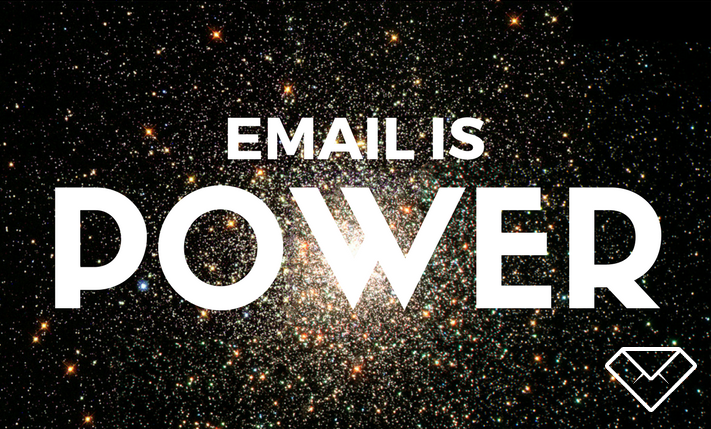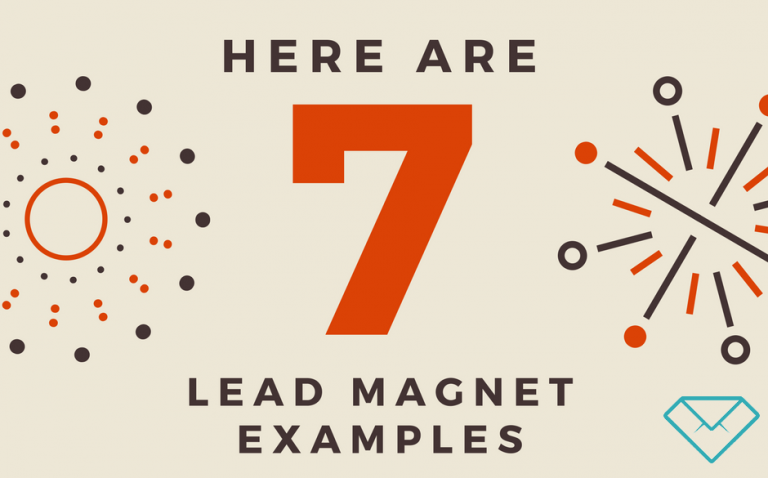Getting Started
You already know that having an email list is important. Because you have read stats like this one from McKinsey all the time:
“Email is 40 times more effective at acquiring new customers than Facebook or Twitter.”

But still, building a list seems like a complicated chore. And who want’s to look like an annoying blogger-come-salesman anyway, right?
Below we dive into the resistance most of us face when asking readers to join our email list. You’ll see why lead magnets can be the solution. And of course, how to create your own lead magnet to turn your blog into a lead generating machine.
Growing Your Blog Doesn’t Mean Selling Out
First things first. Let’s address an issue that many individual bloggers struggle with:
Taking your blog to the next level by collecting emails or monetizing is not the same as selling out.
But at the same time, we get it. You started blogging because you have something to say. You’d hate to pollute your authentic voice by marketing to your readers. And yet, you feel like it’s time your blog grew into an asset rather than just a rambling of words. It’s the classic blogger dilemma.
Most bloggers stay stuck at this crossroads for months or even years. Experimenting with methods to monetize their blog in a way that won’t “annoy” their readers. But ironically, that process of trying to reinvent the wheel might end up bad. With alienating of the bigger part of the audience than one could have ever imagined.
The Acceptance of the “Subscribe” Button
Here’s a poorly kept secret for you: blog readers love to subscribe via email.
In fact, more than 60 percent of marketers use mass email blasts to stay in touch with customers.
Think about it, your readers come to your blog because they value what you’re saying. A large chunk of those same readers wouldn’t mind you popping up in their email inbox with a new piece of content. In fact, many of them would welcome it.
That’s because the email subscription model is tried, tested and accepted by the vast majority of web surfers. Plus, it’s far less annoying than the irrelevant, loud and blinking banner ads you probably use to “monetize” your blog.
Once you have a sizeable email subscriber list, you can use it to:
- Engage. Talk to your audience outside the confines of your blog with new and exclusive content.
- Alert. Notify your subscribers about a new blog post, a live video stream or a social media post that’s going viral.
- Sell. Finally, you can use email blasts to sell products, services or access to premium content.
As you can see, your email subscriber list is going to be one of your most valuable assets. Of course, if you want to take this whole blogging thing seriously.
The Power of Email
Your email list is as good as gold. According to Direct Marketing Association, email marketing on average sees a 4300 percent return on investment. That’s a figure that other forms of marketing simply can’t get near.

Yet, many bloggers still overlook the importance of building an email list. They don’t see the benefits of building a list from day one, putting it off instead until some time in the future. But that’s a common — yet huge — mistake.
Here are three excellent reasons to start building your email list as soon as possible:
1. Email is Personal
When someone signs up for your list they’re giving you permission to get in contact with them.
To quote Seth Godin, “Permission marketing is the privilege (not the right) of delivering anticipated, personal and relevant messages to people who actually want to get them. It recognizes the new power of the best consumers to ignore marketing. It realizes that treating people with respect is the best way to earn their attention.“
And how exactly do you earn that respect? By providing them with consistent value once they’re joined your list.
Plus, email inboxes are very personal spaces. When you’re marketing on social media, or other avenues, you have to compete with the rest of the noise.
But, with email it’s just you and your reader. This more personal form of communication can really help to build trust.
2. Email is Targeted
When someone subscribes they’ve already shown interest in what you’re offering. This means that they want to hear from you.
Generally, your email subscribers are far more receptive to what you’re saying. Whether you’re selling them a new product or letting them know your latest blog post is live.
3. Email is Power
There is a drawback of using other platforms. The same one for Facebook, Twitter, and even your search engine rankings. Your reach is at the mercy of any platform or algorithmic changes. The weakening of the average Facebook like page is proof enough of this.
But when you build an email list, you can contact your subscribers no matter what happens to those other platforms. With a subscriber list, you’re in charge.
So, what’s the most powerful way to entice your readers onto your list in the first place?
Introducing lead magnets.
Introducing Lead Magnets
What is a Lead Magnet?
A lead magnet is an (often downloadable) asset that you give your readers in exchange for their email address.

A lead magnet can come in all shapes and sizes. From eBooks to email courses, to toolkits, to videos, to private discussion groups. The list is endless — and of course, it’s beneficial to offer something as unique as possible.
As we move into 2017, it’s no longer enough to simply show a form on your site that says, ‘join my email list for free updates’. Today, the average web surfer demands value in exchange for their email address.
Thus, you’re going to have to offer them something that they truly want.
Unsurprisingly, this is where most bloggers get hung up. They feel like they don’t have anything of value to giveaway to their readers — but that’s where they’re wrong.
How to Create a Lead Magnet
Turning your blog into a lead generation machine doesn’t have to be difficult. In fact, getting someone to join your list can be simple — so long as your lead magnet is valuable enough to them.
There are two vital hoops to jump through to ensure your lead magnet resonates with your readers.
1. Understand Your Audience
To create an offer that your audience loves you need to understand your audience. There’s no point in creating a lead magnet if your audience doesn’t care about what you’re offering.
After all, your job is to provide them with value. Such immense one that they’re happy, practically begging, to hand over their email address.
By now, you’ve been blogging for a little while. So you probably have some workable data you can use to create something compelling.
Choosing the right topic for your lead magnet is going to be half the battle. To get your juices flowing ask yourself the following questions:
- What topics get the most response from my audience? Social shares? Comments?
- What topic could I easily create a lead magnet for?
- What kind of topics do my readers want to know more about?
- What kind of format could I use to deliver that information?
You don’t have that large of an audience? You can still turn to the Internet to find what kind of topics your ideal readers want answers to.
Here are some simple, yet effective ways to do exactly that:
- Navigate to Buzzsumo. Type in a keyword related to your blog. Sort by social shares to see what blog topics in your niche are the most popular.
- Find relevant forums or Facebook groups in your niche. Spend some time looking for questions or concerns that are consistently voiced.
- Navigate to Amazon’s bookstore. Find your niche and spend some time reading the reviews of books in your space. See if you can find any trends in both the positive and negative reviews.
If you do all of the above your head will probably be brimming with potential lead magnet ideas.
2. Pinpoint Your Value
If you want a high-converting lead magnet, then you’re going to need to focus on the value of your offering. The goal of your lead magnet should be for your readers to be excited to hand over their email address.
This value is often just you solving a very specific problem for your readers. Or maybe finding a way to make their lives a little bit easier.
2.1. Define Your Offer
The best lead magnets are specific. They speak to the solution to a single problem. Making a general promise like, “How to have a better relationship” isn’t enough. That won’t entice someone enough to subscribe to your list. Instead, go for something that you can quantify. For example, “10 Incredible Date Ideas that will cost you less than $10.”
2.2. Brainstorm a Compelling Headline
The most important part of your offer is going to be your headline. Without a compelling headline, your readers won’t even pay attention to your offer. Spend some time brainstorming different headlines that could work with your offer. Very rarely you will get it right the first time around.
Remember, you want a headline that speaks to the emotional side of your reader. And you want the quantified end result of your offer. This entices them to subscribe and they know the exact takeaway they’re going to receive.
2.3. Create Your CTA
Your CTA needs to go beyond ‘subscribe’. The text you have on your subscribe button should be a true call-to-action. This little bit of text is incredibly important to actually get people to subscribe.
To create a solid CTA make sure it’s action based and refers to your lead magnet. For example, “Get the email course”, “Download the eBook”, or “View the checklist”.
2.4. Find the Right Format
Now you know what your lead magnet is going to be about. You have your headline picked out, and you know what your CTA will be, it’s time to think about the format.
Ideally, you’ll be thinking about this as you brainstorm lead magnet offers. But, you’ll need to think about what kind of content your audience likes to consume. You wouldn’t want to offer a free video if your audience prefers written content.
Some audiences will prefer short checklists. Others might like a more detailed eBook. Your earlier research gave you some ideas about the format your audience prefers.
Still struggling with what tangible thing you’re going to offer your subscribers? Then, hopefully, you gain some inspiration from the examples below.
7 Powerful Lead Magnet Examples
It’s easy to overcomplicate the matter of creating a lead magnet. But, often it doesn’t even have to be something that takes a lot of additional work to put together. As long as it provides immediate value to your reader, then that’s all you need.
Below you’ll find seven tried and tested lead magnet ideas that you can adopt, no matter what niche you’re in.

1. An eBook
Far too many bloggers and business owners believe in the same pattern. “Successful and enticing eBook should be massive.” However, a lot of your readers may find an “epic” eBook to be a little overwhelming.
In fact, eBooks that are very targeted can be much more efficient than a massive guide. Because they solve a specific problem for your visitor.
Think of your eBook as a quick win for your subscriber.
For example, an eBook titled ‘How to Make $500 in One Weekend”. It is much more actionable and enticing than one titled ‘How to Make More Money”.
Another great example: Jitendra Vaswani, the Founder of BloggersIdeas.com, offers the free book learning how to double website traffic in 30 days.
The key to a successful lead magnet is having a very specific focus, and an eBook allows you to do that. Plus, this also makes the eBook much easier to create. Because you aren’t trying to create the ultimate guide, you’re just addressing a specific angle.
And if you want to expand on your advice later, you can always update it — or release a new eBook!
2. A Personal Toolkit
Do you have any tools or products you use to run your business?
I’m sure your readers would love to know what tools you use to run your blog and wider brand. As they’ll likely wish to pinch those tools to use for themselves.
become an affiliate
Your toolkit not only gives your readers an inside look into your business. Also, you can become an affiliate for the products you recommend. Which in turn generates revenue.
3. Content Upgrades
A content upgrade is a downloadable that extends the value of an existing blog post. For example, let’s say you wrote a post called ‘The Must Have Guide to Kitchen Spices”. You can create a content upgrade called, “7 Places to find discount high-quality spices”. Offer it in exchange for your reader’s email address.
Content upgrades are usually placed at the beginning, or end, of your existing blog post.
This gives your readers a ton of extra value. And they will much more likely enter their email addresses as it’s highly relevant to what they’ve just read.
4. Automated Email Courses
Email courses are an excellent way to give your readers a ton of value. And at the same time getting them used to opening your emails.
Email courses don’t have to be hard to create either. Essentially, it’s just an autoresponder series. It shows your readers how to complete a simple task. You can even take an in-depth blog post you’ve created, expand on it, and break it down into a series of five emails.
You have a product to sell, or plan on selling something down the road? You can have a quick pitch for your product after the final email in your series.
5. Invitation Only Groups
We all have the common desire to be included, to be apart of something. This is especially true if it’s a private group. You can tap into this human desire of wanting to be part of something exclusive. Create an invitation-only Facebook group.
Creating a Facebook group is great because you don’t have to put a resource together. Your job is to curate a group of like-minded people. This group will also have the benefit of building trust with your audience. In there you’ll be interacting with them on a regular basis.
6. A Checklist or Cheat Sheet
Checklist or cheat sheets are great. They provide immediate value to your subscriber. Whenever they have to perform a repeatable process, all they have to do is consult your resource. As a bonus, whenever they view your checklist you’ll be at the front of their mind.
To create one of these just think of a process that you complete time and time again. Then, map out that process and put it into checklist form.
For example, let’s say you use LinkedIn to generate new leads for your consulting business. You could create a simple walkthrough about it. It will guide your readers through this exact same process for their business.
7. An Expertly Curated Resource List
Resource lists can be very valuable as they can be big time savers. Especially, because your readers will look to you as an expert, and if you vouch for something, then it must be good.
Think of your resource list as the single place your reader has to go to for the relevant information on a topic. Best of all, you don’t even have to write it all yourself.
You’re simply acting as a curator and pulling together all the best available resources.
This list could even be as simple as listing the best blog posts on a given topic. For example, let’s say you’re a new mommy blogger. You could offer a resource list that compiles all the best blogs on getting your newborn to sleep.
The Final Checklist
Now you understand what it takes to create a compelling lead magnet. It’s time to go over the final checklist, so you can get started creating your lead magnet in no time at all.
Here’s everything you need to consider and act upon to create a successful lead magnet. The one that actually grows your email list from your blog:
- The Power of Email. Remind yourself that to grow your blog, you need to grow your list, and lead magnets are the first step
- Identify Your Audience. Spend some time getting to know your audience’s needs, desires, wishes, and pain points
- Choose The Problem. Get specific with your offer and choose a problem you can quickly solve via your lead magnet
- Select Your Format. As we have discussed, lead magnets come in all shapes and sizes. Select your preferred format, and start building.
- The Call to Action. Once Your lead magnet is ready, set it up on your blog’s home page with a compelling call to action (CTA). That will entice your readers to part with their email address in exchange for the asset.
As your site grows you gain experience with creating lead magnets. You can even create several to address different needs of your market. With multiple lead magnets and content upgrades, you’ll see your email list consistent growth.[/vc_column_text]
Remember, Always Lead With Value
When you’re creating your lead magnet always keep your readers at the forefront of your mind.
Make your lead magnet about solving one of their problems. The more you do so, the greater your lead magnet will convert. Similarly, the better you get at improving your readers’ lives the more they’ll come back to you.
Once you’ve settled on the lead magnet you’re going to create, it’s time to get to work. But don’t over complicate things. The more basic and to the point you can be, the easier it’ll be for your new subscriber to digest and put to use.
With your lead magnet all polished up, you can then integrate it into a beautiful Optin. This way every new email subscriber will be sent to your email marketing platform. No matter which one you use – MailChimp, Campaign Monitor, Aweber or any other.
Still have questions about creating your very own lead magnet? Let us know your questions and we’ll answer them in the comments below!
–
Image: Negative Space
 Why Noreply Email Address Is BAD for Email Marketing and What to Do Instead
Why Noreply Email Address Is BAD for Email Marketing and What to Do Instead How DigitalMarketer Makes $14.1M Revenue
How DigitalMarketer Makes $14.1M Revenue